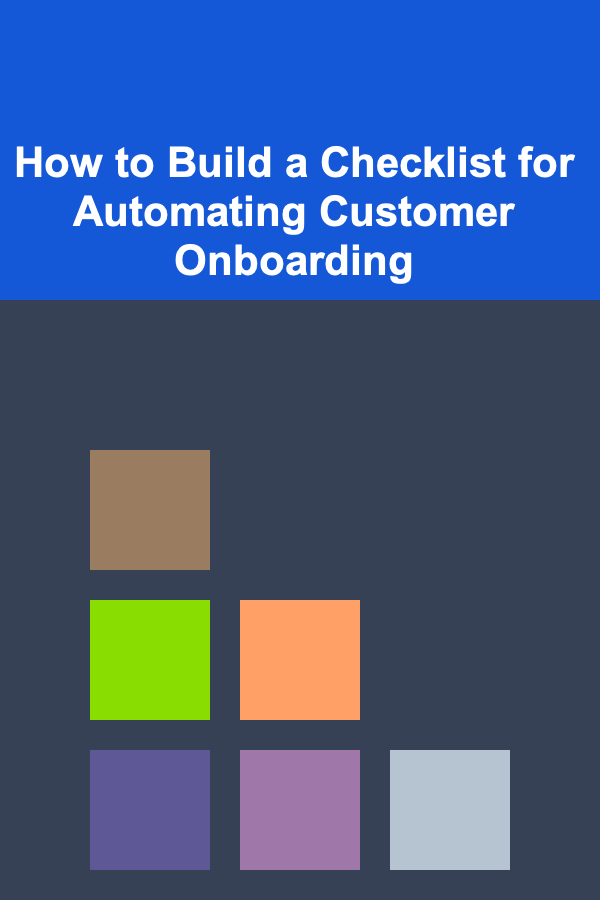
How to Build a Checklist for Automating Customer Onboarding
ebook include PDF & Audio bundle (Micro Guide)
$12.99$9.99
Limited Time Offer! Order within the next:

Customer onboarding is a critical process for any business that wants to ensure a smooth transition from prospect to customer. A well-executed onboarding experience can improve customer retention, drive product adoption, and ultimately contribute to higher lifetime value. Automating the onboarding process can significantly enhance efficiency and consistency, allowing your team to focus on more personalized aspects of customer interaction.
In this actionable guide, we'll walk you through how to build a checklist for automating customer onboarding. This checklist will help you streamline your onboarding process, reduce manual effort, and provide a consistent, high-quality experience for every customer.
Step 1: Define the Objective of Your Onboarding Process
Before diving into automation, it's essential to define the specific objectives you want your onboarding process to achieve. Are you looking to increase product adoption, reduce churn, or educate customers about key features? Clarifying your goals will help you design a more effective and targeted automation flow.
Key Considerations:
- Primary Goal: What is the primary aim of your onboarding? Do you want to drive early engagement, ensure customers understand your product's value, or encourage them to take specific actions?
- Customer Segmentation: Are you onboarding different types of customers (e.g., B2B vs. B2C) or customers with different needs? Tailoring your automation for different segments will enhance the experience.
- Time Frame: Do you want your onboarding to take place over days, weeks, or months? The length of the onboarding process will affect the design of your automation.
Actionable Steps:
- Write a mission statement for your onboarding process that aligns with customer needs and business objectives.
- Segment your customers based on key factors (industry, size, use case) and design separate onboarding journeys if necessary.
- Set clear KPIs (Key Performance Indicators) to measure the success of your automated onboarding efforts.
Step 2: Map the Customer Journey
Mapping the customer journey during onboarding helps identify the critical touchpoints and stages that need to be automated. By understanding where customers typically encounter obstacles or drop off, you can design an automation strategy that addresses these pain points and leads to higher success rates.
Key Considerations:
- Touchpoints: What are the key moments when a customer interacts with your product or team during onboarding? These might include registration, initial setup, or feature discovery.
- Pain Points: Where do customers tend to struggle during onboarding? Is there confusion about how to use features, or do they need more guidance in the early stages?
- Engagement Levels: How frequently do customers need to engage with your product during the onboarding process? Will they need reminders or nudges to keep them engaged?
Actionable Steps:
- Create a visual map of the customer journey, highlighting each stage of the onboarding process.
- Identify stages where customers need the most support, such as registration, product setup, or learning key features.
- Set up automated emails, in-app notifications, or reminders to guide customers through the most critical touchpoints.
Step 3: Choose the Right Tools for Automation
Selecting the right tools for automating your customer onboarding process is crucial. A variety of software solutions exist to streamline different aspects of onboarding, from email marketing platforms to customer relationship management (CRM) systems and in-app guides.
Key Considerations:
- Integration: Does the automation tool integrate well with your existing platforms (CRM, email, help desk, etc.)? Seamless integration will reduce manual work and help keep customer data organized.
- Customization: Can the tool be tailored to fit your specific onboarding process? Your customers' experience should feel personalized, even when automation is involved.
- Tracking and Analytics: How easily can you track the success of your automated onboarding process? Analytics will provide valuable insights into where improvements are needed.
Actionable Steps:
- Evaluate tools like HubSpot, Intercom, or WalkMe that offer specific onboarding automation features.
- Make sure the tool integrates with your CRM, email system, and other tools you're using for customer management.
- Set up tracking for user interactions during onboarding (e.g., feature adoption, email opens, and completion rates) to assess success.
Step 4: Design Automated Communication Flows
Communication is at the heart of customer onboarding, and automating it ensures that no customer falls through the cracks. You'll need to design communication flows that engage customers at key moments during their onboarding journey.
Key Considerations:
- Email Campaigns: Automated email campaigns can guide users through onboarding, offering tutorials, product tips, and support information. The timing, frequency, and content of these emails are crucial.
- In-App Messaging: If you have an app or software product, in-app messages or tooltips can provide real-time assistance, such as feature tutorials or welcome messages.
- Personalization: Personalizing your communication based on customer data (e.g., name, usage patterns) can improve engagement and customer experience.
Actionable Steps:
- Create a series of automated emails that guide customers through key onboarding stages (e.g., welcome email, product setup, feature tutorials, etc.).
- Implement in-app messages or walkthroughs for key product features.
- Use dynamic content in emails or in-app messages to personalize communication based on customer actions or data.
Step 5: Automate Data Entry and Customer Information Gathering
During the onboarding process, you'll need to collect essential customer information, such as preferences, industry details, or usage habits. Automating this data collection can save time and ensure accuracy. You can use forms, surveys, or automated integrations to gather the data you need.
Key Considerations:
- Data Capture: What data do you need to collect from customers during onboarding? Is it demographic, behavioral, or product-specific?
- Data Accuracy: Automated data capture can help eliminate errors from manual entry. How do you ensure that the data you collect is accurate and useful for later stages?
- Data Privacy: Be sure to handle customer data responsibly, especially if you're collecting sensitive information. Automate data protection measures where possible.
Actionable Steps:
- Use forms, quizzes, or surveys to automatically collect customer data during onboarding.
- Integrate your onboarding tool with CRM or customer databases to auto-fill information and reduce manual data entry.
- Set up automated reminders for customers who haven't completed key data collection steps (e.g., filling in profile details or connecting integrations).
Step 6: Provide Self-Service Resources
Incorporating self-service resources such as knowledge bases, FAQs, video tutorials, and community forums can empower customers to help themselves during the onboarding process. Automating the delivery of these resources can guide customers to the right information at the right time.
Key Considerations:
- Self-Service Availability: Make sure resources are easily accessible and up-to-date. A knowledge base or help center can answer common questions without requiring live support.
- Automated Assistance: Use chatbots or virtual assistants to provide instant answers to customer questions, guiding them to the appropriate resources or providing real-time help.
- Customer Education: How can you educate your customers to get the most out of your product? A combination of tutorials, webinars, and onboarding materials can enhance this.
Actionable Steps:
- Build or integrate a self-service help center that's easily accessible from within your product or via email.
- Set up automated suggestions to direct customers to relevant resources based on where they are in the onboarding process.
- Use chatbots or automated messages to answer common customer questions or direct them to the appropriate knowledge base article.
Step 7: Monitor and Optimize Your Automation Workflow
Once your automation is live, it's important to continuously monitor its performance. Are customers successfully completing the onboarding process? Are there stages where customers drop off or get stuck? The data from your automated workflows will provide valuable insights into areas that need optimization.
Key Considerations:
- Success Metrics: Measure the effectiveness of your onboarding automation with metrics like onboarding completion rates, user engagement, and feature adoption.
- Feedback Loops: Collect feedback from customers on their experience with the automated process. Are there gaps in the flow? Do they feel supported?
- Iterative Improvement: Continuously improve your automation workflow based on data and customer feedback. Identify bottlenecks and address them.
Actionable Steps:
- Set up performance dashboards to track onboarding success rates and feature adoption.
- Use A/B testing to optimize email messaging, communication timing, or in-app guidance.
- Regularly collect customer feedback to improve your automation process over time.
Conclusion
Automating customer onboarding can greatly enhance your business's efficiency, providing customers with a seamless and personalized experience while reducing the manual effort involved. By following this checklist and continuously refining your processes, you can build an automated onboarding system that not only engages customers but also drives long-term satisfaction and retention.
Reading More From Our Other Websites
- [Home Budget Decorating 101] How to Give Your Entryway a Budget-Friendly Makeover
- [Organization Tip 101] How to Utilize Old Shoe Boxes for Craft and School Supply Storage
- [Organization Tip 101] How to Organize Your Car for Quick Errands
- [Organization Tip 101] How to Create a Minimalist Toy Collection
- [Home Family Activity 101] How to Unleash Creativity: Simple Steps for Making Homemade Greeting Cards as a Family
- [Personal Finance Management 101] How to Manage Debt Effectively: Strategies for Paying Off Loans Faster
- [Hiking with Kids Tip 101] Allergy-Safe Hiking Snacks: Safe & Tasty Options for Every Child
- [Home Renovating 101] Best Farmhouse Home Renovations: Rustic Charm & Modern Updates for a Cozy Retreat
- [Personal Investment 101] How to Choose High-Yield Savings Accounts as Part of Your Investment Strategy
- [Home Lighting 101] How to Style a Dining Room with Pendant Lighting

How to Maximize Rental Income with Simple Home Improvements
Read More
How to Soundproof an Apartment's Common Walls
Read More
How to Store Out-of-Season Clothes Safely
Read More
How to Update Your Kitchen with Affordable DIY Projects
Read More
How to Develop Blockchain Oracles for Real-World Data
Read More
How to Identify Antique Postcards: A Beginner's Guide
Read MoreOther Products

How to Maximize Rental Income with Simple Home Improvements
Read More
How to Soundproof an Apartment's Common Walls
Read More
How to Store Out-of-Season Clothes Safely
Read More
How to Update Your Kitchen with Affordable DIY Projects
Read More
How to Develop Blockchain Oracles for Real-World Data
Read More